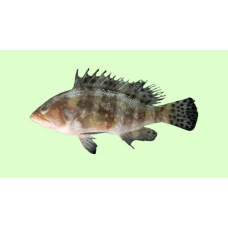Latin name
Epinephelus sexfasciatus
Other name
Sixbar rockcod or six-banded rockcod.
Identification
In the six-bar grouper, the standard body length is 2.7-3.2 times its thickness. The dorsal profile of the head is convex and the intraorbital region is flat or slightly convex. The anterior eyelid has 2-4 strongly enlarged serrations at an angle. The upper margin of the eyelid is straight. The upper jaw reaches vertically or slightly beyond the posterior margin of the eye.
Features of fish fins
The dorsal fin has 11 spines and 14-16 soft rays, while the anal fin has 3 spines and 8 soft rays. The webs between the spines in the dorsal fin are deeply incised. The caudal fin is rounded.
Fish colouring
Head and body colouring is light greyish-brown with 5 dark brown vertical stripes on the body and 1 vertical stripe on the dorsal side of the head, there may be a scattering of lighter spots on the body and sometimes indistinct small brown spots along the edges of the dark stripes. The soft radial parts of the dorsal, caudal and pelvic fins are dark grey and the pectoral fins are greyish or orange-red. In some individuals the jaws and lower part of the head are pale reddish brown.
Distribution
Widespread in the southwest Pacific from Thailand in the west, through the Malay Archipelago to Papua New Guinea and the Philippines in the east, north to Taiwan and south to Australia.
Habitat
A tropical marine species associated with reefs. Habitat depths range from 10 to 80 metres.
Size
The maximum recorded total length is 40 centimetres.
Behavior
The six-bar grouper lives on muddy, sandy or muddy bottoms. Its preference for soft-bottom habitats may explain its limited distribution and absence from oceanic islands.
Food and feeding habits
This species feeds on small fish and crustaceans.
Reproduction
It is a sequential protogynous hermaphrodite. At the beginning of the life cycle, all individuals are exclusively female, and only some adult fish change sex to become male. Fertilisation is external. Eggs are pelagic, with a single fat droplet and no appendages. Larvae are pelagic and are carried long distances by currents.
Fishing
It is a commercial fishery and appears in markets in many parts of its range.
Relationship with a person
Harmless. Found in aquarium shops.
| Classification | |
| Phylum | Chordata |
| Class | Actinopterygii |
| Squad | Perciformes |
| Family | Serranidae |
| Genus | Epinephelus |
| Species | E. sexfasciatus |
| Features | |
| Conservation status | Least Concern |
| Habitat | Pelagic |
| Life span, years | No information |
| Maximum body weight, kg | No information |
| Maximum length, cm | 40 |
| Sailing speed, m/s | No information |
| Threat to people | Edible |
| Way of eating | Predator |
Sixbar grouper
Tags: sixbar grouper

